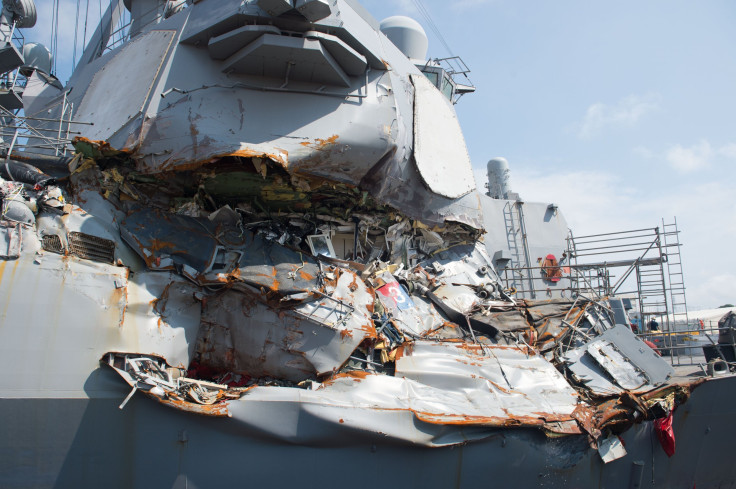USS Fitzgerald Leaves Japan, Heads To Mississippi For Repairs After Collision

The USS Fitzgerald, Arleigh Burke-class guided missile destroyer, which was involved in a deadly collision on June 17, leaving seven sailors dead and the ship with severe damages, left the port of Yokosuka, Japan, on Friday (Thursday on the West coast), and is expected to arrive at Pascagoula, Mississippi, for repairs.
Although the Fitzgerald has a capacity of 300, only 50 crew members were onboard the ship when it set sail for the United States. After the Fitzgerald collided with a Philippine-flagged merchant ship ACX Crystal, 56 nautical miles off the coast of Honshu, Japan, two senior officers and a senior enlisted sailor were let go off, by the navy.
7th Fleet spokesman Cmdr. Clay Doss previously told Stars and Stripes: "The majority of [Fitzgerald] sailors — but not all — will have opportunities to serve other commands in Japan based on available billets, individual crew desires and the needs of the Navy. Some sailors do not desire reassignment in [Japan] and have asked for orders to other locations."
After the collision, the Fitzgerald had to be given temporary fixes to prepare it for a long journey across the ocean. Months before it could set sail again, Japanese technicians and shipbuilders worked on it, dewatering and defueling it. In addition, hull and superstructure repairs were made and key systems were placed in layup maintenance. In preparing for the move, the ship was moved from dry dock to a pier-side location in October, the Defense Video Imagery Distribution System reported.
Fitzgerald was lifted onto the transport vessel Transshelf which will transport Fitzgerald to Huntington Ingalls Industries (HII) for repairs and upgrades. HII was chosen to repair the Fitzgerald because the company would be able to restore the ship, which suffered extreme damage on her starboard side above and below the waterline, in the shortest span of time
Naval Sea Systems Command issued the following statement in August: "Given the complexity of the work and the significant unknowns of the restoration, the Navy determined that only an Arleigh Burke-class shipbuilder could perform the effort." The date of beginning repairs, its scope, cost and the estimated timeline are yet to be determined, the statement added.

In an extensive report, released on Nov. 1 of the collision, it was seen that Fitzgerald’s pre-approved navigation track did not account for or follow the area’s vessel traffic separation (VTS) patterns. The ship also did not broadcast an AIS signal and all her exterior lights were extinguished, except the ones lit for navigation, making it harder for other vessels in the area to spot it.
Apart from these errors, the Officer of the Deck (OOD), also failed to perform his duties properly. After failing to radar track the ACX Crystal, a junior officer of the deck visually sighted it and noted that its course would coincide with Fitzgerald's track. Despite the junior officer recommending that the ship be slowed down, the OOD remained convinced that Crystal would pass at a safe distance. As a result, he did not order the Fitzgerald’s speed to be altered.
It was also recorded that at no point before or after Crystal had collided with the Fitzgerald did the bridge watchstanders on either of the ships make radio contact. In addition, none of the crew members on the Fitzgerald sounded the general alarm to warn their shipmates of an impending collision.
© Copyright IBTimes 2024. All rights reserved.






















